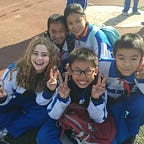Education, Memorization, and Innovation in a Chinese High School
This article was written at the end of my time in Beijing as part of a cumulative capstone project that tested language and cultural competence. Together with two other group members, I chose to investigate the Chinese educational system. You can find the rest of the project (which includes a podcast and short video) here.
American leaders tend to regard China’s education system as an enigmatic success story, both laudable and threatening to American dominance. For decades, educators and policy-makers alike took China’s high scores on international examinations as an example of educational superiority, and devised plans to raise American test scores to a similar level. China was seen by experts as a clear leader in the scholastic field.
Lately, though, Western media has focused on less commendable aspects of the Chinese school system, like the signature emphasis on rote memorization. Although high test scores are praised, the Chinese education system is criticized for failing to encourage creativity and innovation. Perspectives presented remain mixed and sometimes contradictory, and first-hand reports are few and far between. What was really going on? As American students living in China, we felt that we were uniquely poised to observe the genuine Chinese high-school experience.
Our first step was to sit in on a class that was in some ways emblematic of the traditional Chinese teaching style. When we entered Ms. Yin’s literature class at Beishida Erfuzhong, a prestigious and progressive Beijing high school, we saw what we expected to see — — to an extent. Although Ms. Yin stood at the front of the classroom lecturing for the majority of the period, she also made time for students to analyze text independently or in small groups. This less rigid approach seemed to contradict the prevailing stereotype of Chinese teachers as dry, humorless lecturers.
Ms. Yin believed her more interactive approach was made possible in part by certain educational reforms in China, which grant public school teachers more control over lesson planning. Thus, instead of being forced to simply lecture, Ms. Yin had the freedom to arrange group activities and better foster creativity amongst her students.
To better understand the more innovative classes perhaps made possible by these nebulous reforms, we visited a robotics elective introduced by Erfuzhong in 2013. As we entered the robotics area (which consisted of three separate classrooms plus a small display hall) the contrast between this part of the building and others was immediately apparent; the robotics classrooms were white and airy, boasting futuristic ceiling designs and a line of 3-D printers, while the literature classroom we visited earlier was drab, with endless rows of desks and a podium for the teacher. In this environment, so clearly designed with innovation in mind, we watched small groups of students work together to build a robot, while their teacher, Mr. Bei, moved around and advised them.
When asked about the benefits of taking his course, Mr. Bei discussed the importance of individualism even in a group situation, saying that the students “must learn to clearly express their individual thought processes and opinions.” However, he went on to focus on the lessons of teamwork learned in robotics, emphasizing that “to build robots, one person certainly cannot make one alone. One person alone is hopeless. The students are required to work together.” In this distinctly modern Chinese class, the emphasis is not placed on accumulation of knowledge or memorization, but instead on character development, innovation, and creativity.
